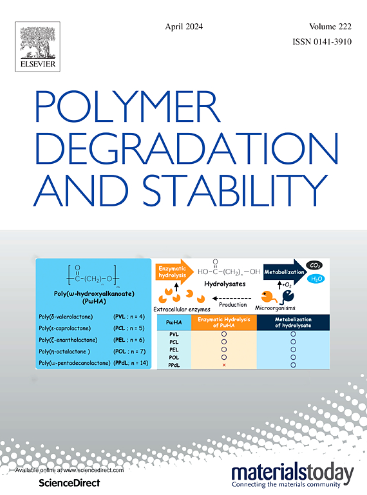Multiple synergistic effects of copper salicylaldehyde-modified P-N inorganic-organic hybrid in enhancing flame retardancy, smoke suppression, and anti-dripping properties of TPU
IF 6.3
2区 化学
Q1 POLYMER SCIENCE
引用次数: 0
Abstract
In recent years, significant progress has been made in the research of flame-retardant thermoplastic polyurethane (TPU) elastomers. However, challenges persist in balancing the enhancement of flame retardancy, smoke suppression, and anti-dripping properties with the preservation of mechanical properties. To address this challenge, a copper salicylaldehyde-modified P-N inorganic-organic hybrid flame retardant (P-N@CuSA) has been prepared and used to improve both the fire safety and mechanical property of TPU in this work. The experimental results showed that the incorporation of 4 wt% P-N@CuSA leads to a 65.1 % reduction in peak heat release rate, a 31.9 % decline in total smoke production, and a 31.3 % decrease in total carbon monoxide production for TPU/4 %P-N@CuSA compared with pure TPU (TPU/0). Notably, 4 wt% P-N@CuSA endowed TPU with a UL-94 V-0 rating without melt dripping. Further analysis of the thermal degradation behavior of TPU composites, combined with an examination of the char residue structure after the cone calorimeter test (CCT), reveals that P-N@CuSA acts through both gas-phase and condensed-phase flame retardant mechanisms during combustion. It subtly alters the thermal cracking trajectory of TPU composites and promotes the formation of a high-quality char residue layer, which serves as a formidable barrier against heat transfer and gas emission. As a result, this innovative approach significantly enhances the overall fire safety performance of TPU materials. This work presents a new strategy for the chemical modification of phosphorus-nitrogen-based flame retardants (P-N FRs) by metal chelates, offering a fresh perspective for the development of fire-safe composites.

水杨醛铜改性 P-N 无机有机杂化物在增强热塑性聚氨酯阻燃、抑烟和防滴性能方面的多重协同效应
本文章由计算机程序翻译,如有差异,请以英文原文为准。
求助全文
约1分钟内获得全文
求助全文
来源期刊

Polymer Degradation and Stability
化学-高分子科学
CiteScore
10.10
自引率
10.20%
发文量
325
审稿时长
23 days
期刊介绍:
Polymer Degradation and Stability deals with the degradation reactions and their control which are a major preoccupation of practitioners of the many and diverse aspects of modern polymer technology.
Deteriorative reactions occur during processing, when polymers are subjected to heat, oxygen and mechanical stress, and during the useful life of the materials when oxygen and sunlight are the most important degradative agencies. In more specialised applications, degradation may be induced by high energy radiation, ozone, atmospheric pollutants, mechanical stress, biological action, hydrolysis and many other influences. The mechanisms of these reactions and stabilisation processes must be understood if the technology and application of polymers are to continue to advance. The reporting of investigations of this kind is therefore a major function of this journal.
However there are also new developments in polymer technology in which degradation processes find positive applications. For example, photodegradable plastics are now available, the recycling of polymeric products will become increasingly important, degradation and combustion studies are involved in the definition of the fire hazards which are associated with polymeric materials and the microelectronics industry is vitally dependent upon polymer degradation in the manufacture of its circuitry. Polymer properties may also be improved by processes like curing and grafting, the chemistry of which can be closely related to that which causes physical deterioration in other circumstances.
 求助内容:
求助内容: 应助结果提醒方式:
应助结果提醒方式:


